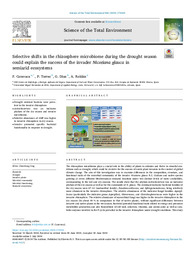Please use this identifier to cite or link to this item:
https://hdl.handle.net/11000/34867Full metadata record
| DC Field | Value | Language |
|---|---|---|
| dc.contributor.author | Díaz Espejo, Gisela | - |
| dc.contributor.author | Caravaca, Fuensanta | - |
| dc.contributor.author | Torres, Pilar | - |
| dc.contributor.author | Roldan, Antonio | - |
| dc.contributor.other | Departamentos de la UMH::Biología Aplicada | es_ES |
| dc.date.accessioned | 2025-01-18T08:12:37Z | - |
| dc.date.available | 2025-01-18T08:12:37Z | - |
| dc.date.created | 2024 | - |
| dc.identifier.citation | Science of the Total Environment | es_ES |
| dc.identifier.issn | 1879-1026 | - |
| dc.identifier.issn | 0048-9697 | - |
| dc.identifier.uri | https://hdl.handle.net/11000/34867 | - |
| dc.description.abstract | The rhizosphere microbiome plays a crucial role in the ability of plants to colonize and thrive in stressful conditions such as drought, which could be decisive for the success of exotic plant invasion in the context of global climate change. The aim of this investigation was to examine differences in the composition, structure, and functional traits of the microbial community of the invader Nicotiana glauca R.C. Graham and native species growing at seven different Mediterranean semiarid locations under two distinct levels of water availability, corresponding to the wet and dry seasons. The results show that the phylum Actinobacteriota was an indicator phylum of the dry season as well as for the community of N. glauca. The dominant indicator bacterial families of the dry season were 67–14 (unclassified family), Pseudonocardiaceae, and Sphingomonadaceae, being relatively more abundant in the invasive rhizosphere. The relative abundances of the indicator fungal families Aspergillaceae (particularly the indicator genus Aspergillus), Glomeraceae, and Claroideoglomeraceae were higher in the invasive rhizosphere. The relative abundance of mycorrhizal fungi was higher in the invasive rhizosphere in the dry season (by about 40 % in comparison to that of native plants), without significant differences between invasive and native plants in the wet season. Bacterial potential functional traits related to energy and precursor metabolites production and also biosynthesis of cell wall, cofactors, vitamins, and amino acids as well as catabolic enzymes involved in the P cycle prevailed in the invasive rhizosphere under drought conditions. This study shows that the pronounced and beneficial shifts in the microbiome assembly and functions in the rhizosphere of N. glauca under conditions of low soil water availability can represent a clear advantage for its establishment. | es_ES |
| dc.format | application/pdf | es_ES |
| dc.format.extent | 15 | es_ES |
| dc.language.iso | eng | es_ES |
| dc.publisher | Elsevier | es_ES |
| dc.relation.ispartofseries | 946 | es_ES |
| dc.rights | info:eu-repo/semantics/openAccess | es_ES |
| dc.rights | Attribution-NonCommercial-NoDerivatives 4.0 Internacional | * |
| dc.rights.uri | http://creativecommons.org/licenses/by-nc-nd/4.0/ | * |
| dc.subject | Drought | es_ES |
| dc.subject | Invasive plants | es_ES |
| dc.subject | Microbial community | es_ES |
| dc.subject | Microbial functioning | es_ES |
| dc.subject | Semiarid ecosystems | es_ES |
| dc.subject.other | CDU::5 - Ciencias puras y naturales::58 - Botánica | es_ES |
| dc.title | Selective shifts in the rhizosphere microbiome during the drought season could explain the success of the invader Nicotiana glauca in semiarid ecosystems | es_ES |
| dc.type | info:eu-repo/semantics/article | es_ES |
| dc.relation.publisherversion | https://doi.org/10.1016/j.scitotenv.2024.174444 | es_ES |

View/Open:
64-Investigación_articulos_Selective Shifts STOTEN.pdf
6,56 MB
Adobe PDF
Share:
.png)
